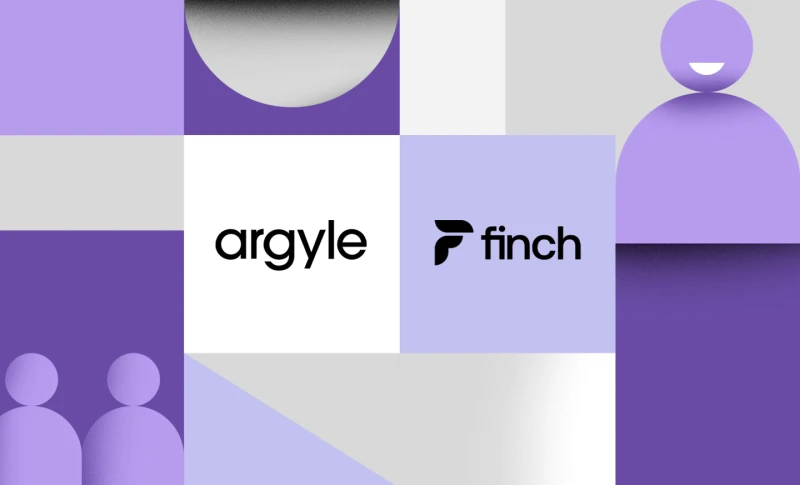Industry leaders Argyle and Finch represent two ends of the employment data spectrum.
Across industries, having ready access to highly accurate employment data — customer names, salaries, hire dates, job titles, hours worked, etc. — has long been elusive.
Fortunately, a new crop of digital gateways has finally made real-time employment data accessible, to the benefit of third-party service providers, employers, and workers alike. Leading the way? Argyle and Finch, two companies at the forefront of API-enabled employment data access, albeit with two very different customers and end-users in mind.
The Employment Data Problem
Before we dive headfirst into Argyle and Finch, let’s take a step back. Employment data has historically been (and currently still is) stored behind employment and payroll platforms. The bespoke nature of employment record storage has rendered the data untransferable, leaving platforms with the control over employment data, As those of us at Argyle and Finch see it, ownership should instead be in the hands of the customers and end-users of the payroll systems themselves: employers and their workers.
Argyle and Finch are among a new generation of businesses unlocking the potential of payroll and employment data through API technology. Our technology makes it possible to access real-time, structured, sanitized, and standardized employment data in a secure, instantaneous, and continuous way, so employers and workers can use it to their advantage and full potential.
Most importantly, both Argyle and Finch leverage a user-permissioned model, which means that the data’s true owners (employers and workers) are finally calling the shots when it comes to how their data is utilized. Unsurprisingly, modern financial service providers like lenders, insurance brokers, and money management companies are building their infrastructure on top of these APIs to gain transparency into employment data and improve their product experiences.
The Flavors of Employment Data Access
Of course, not all employment data APIs are created alike; different APIs serve different customers, end-users, and use cases. Argyle and Finch are perfect examples. Together, we represent the two distinct flavors of best-in-class, user-permissioned employment data access.
Argyle: Worker-Permissioned Employment Data
When an individual applies for something like a personal loan, mortgage, workers comp, auto financing, or life insurance, or tries to rent an apartment, they need to provide proof of their employment and income, which an underwriter analyzes to assess that individual’s ability to make on-time and complete payments. That’s where Argyle comes in.
Embedded as a widget in an app, website, or platform, Argyle prompts said individual to provide credentialed access into their online work account, granting the third-party service provider (e.g., the lender) they are working with visibility into their personal employment data, including fields like their date of birth, address, gross and net salary, job tenure, and more (for a detailed list of available data fields, see Argyle's documentation). In turn, said third-party has the accurate, comprehensive information they need to confidently provide that individual with a service like a loan or mortgage, without taking on undue risk. We call that a win-win.
“While we target different use cases, both Finch and Argyle are selling trust. When you look at how the Argyle team communicates this to users through their docs and design, it’s clear that they understand the responsibility that comes with handling employment data,” said Jeremy Zhang
Finch: HR Administrator-Permissioned Employment Data
On the other end of the employment data API spectrum is Finch, the first employer-focused payroll and human resources API. Instead of workers, Finch’s end users are HR administrators, who credential into their employer’s payroll system to give data access to third-party service providers like benefits and tax credit platforms, small- to medium-size insurance providers, and financial planning software companies.
When an HR administrator authorizes access to their employer’s payroll system, Finch’s API can read the entire organization’s employee census, personal data, and detailed pay statements, securely retrieving and presenting it in a clean, standardized format for service providers to ingest (for a list of available data fields, see Finch's documentation). Access to this live data allows service providers to unlock new insights and automate processes that the HR admin would otherwise have to complete manually. Everybody’s happy.
The Path Forward for Employment Data
Together, Argyle and Finch represent the disruptive present and future of employment data—one that transfers power and control over employment data into the hands of workers and employers.
Simultaneously, we make employment data more accessible, more usable, and more effective for the lenders, underwriters, banks, financial management companies, insurance and benefits providers, and more who rely on employment data to perform VOIE and otherwise provide a better experience to their users. For these companies, our solutions offer more transparency, more efficiency, a better user experience, higher capture and conversion rates, and more accurate, informed, and confident decision-making.
“The Finch team has taken a deeply thoughtful approach to the employer access point into these systems. The standardized authorization flow, permission levels, and data model are all key elements to create a secure, compliant transfer of employment data from employers to the service providers they trust,” said Shmulik Fishman
Please get in contact with Argyle or Finch to learn more about what we offer and how we can change the nature of employment data access for your business. We’re excited to see what innovative products of yours can be built on top of our systems.


